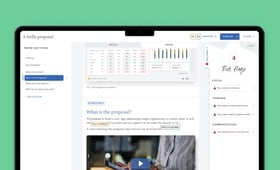As research by Deloitte shows, boards are increasingly seeking ways to get through their expanding workload more efficiently — so much so that board effectiveness has itself become an agenda item.
One solution being used by many boards is the consent agenda. Also known by Robert's Rules of Order as a “consent calendar,” a consent agenda groups routine meeting discussion points into a single agenda item. The grouped items can then be approved in one action, rather than through the filing of multiple motions.
The result is shorter board meetings which devote a higher proportion of the available time to strategic matters. This is important, because boards often struggle to maintain their big picture focus. A recent Board Intelligence survey found that 91% of business leaders wanted their board to spend less time in the weeds and more time on the organisation’s vision and goals.
What is the purpose of a consent agenda?
Boards operate in an unpredictable environment, with multiple stakeholders and expanding workloads: 70% of directors surveyed by Spencer Stuart reported increased demands on their time, and 30% said the role takes more time than expected. Small wonder, then, that nearly half of directors feel their board isn’t adding enough value, with a third believing it adds no value at all.
While boards want to spend more time on strategy, nobody wants longer meetings. This is where consent agendas can be useful — by helping to clear routine items efficiently, they create more space on the agenda for important matters.
Directors still review all materials in advance and can pull any item for separate discussion if needed, which means that the board can handle standard business efficiently without sacrificing oversight, assurance, or transparency.
What common items should be included in a consent agenda?
Common items for a consent agenda are generally described as routine, non-controversial, and non-material. They typically include:
- Approving previous meeting minutes
- Reviewing routine financial reports
- Committee updates
- Regulatory filings and compliance updates
- Contract renewals without major changes
- Minor policy amendments
- Membership or appointment approvals
- Housekeeping resolutions (for example, setting the next meeting date)
With Board Intelligence’s board portal, supporting materials for these discussions can be distributed seamlessly and items can be reviewed and approved electronically.
A tool like Agenda Planner, available within Board Intelligence’s board portal, can also help. Offering a complete view of your board’s forward calendar, Agenda Planner makes it easy to take a step back from the detail to see the big picture — so you can spot opportunities to group routine agenda items like minutes, standard reports, and approvals into a ‘consent agenda’ category. You can quickly ‘drag and drop’ items to move them across meetings, board and management papers included, and automatically update timings as well as page numbers in the board pack. This is ideal for pulling routine items into consent agendas without disrupting the broader agenda flow or creating a mountain of paperwork.
Another benefit is agenda analytics: Agenda Planner enables you to tag items and monitor how the board is spending its time across different topics. For example, you can measure time spent on steering topics versus supervising items or across strategy, performance, and governance topics. Armed with this data, you can track and adjust the balance between routine consent items and strategic priorities.
For expert tips and insights, read our guide to mastering the board agenda.
What are the benefits of using a consent agenda in board meetings?
Using a consent agenda in board meetings offers several governance and efficiency benefits:
- Makes more efficient use of limited meeting time. Bundling routine, non-controversial items into one vote frees up the agenda for strategic discussion.
- Maintains the board’s focus on high-value topics. Reducing the time spent on operational details means boards can engage more deeply with long-term priorities.
- Improves meeting flow. Fewer interruptions for minor approvals make it easier for the chair to keep discussions on track.
- Encourages better meeting preparation. Board members are expected to review consent items in advance, promoting discipline and accountability.
- Strengthens governance. Separating routine items from strategic decisions means boards can meet their oversight responsibilities while also providing forward-looking guidance.
How can a consent agenda improve meeting efficiency?
Effective meeting preparation begins with a focused agenda that aligns with the organisation’s priorities and looks ahead. Too often, boards get the opposite: agendas that are bogged down in operational detail and backward-looking updates rather than agendas that are focused on current priorities and future opportunities. Research shows that only 44% of boards spend more meeting time looking forward than backwards.
Consent agendas increase efficiency with bulk approval of standard items. This streamlined process reduces the proportion of meeting time that is spent on procedural matters, cuts down on administrative back-and-forth, and creates a more predictable and manageable meeting flow.
Consent agendas also drive bigger picture benefits, by making it easier to tap into the collective intelligence of the board. Directors can devote more of their energy and attention to agenda items that require active debate and strategic thinking, rather than procedural formalities. When board members have more time to challenge, shape, and stretch management’s thinking and plans, discussions are more likely to surface breakthrough thinking – and, ultimately, move the needle for the organisation.
Get smart agenda planning software that focuses board time and expertise on the conversations and decisions that matter most.
See agenda plannerWhat are the best practices for preparing a consent agenda?
Here are the best practices for preparing a consent agenda that keeps meetings efficient without compromising on governance:
- Define “consent-worthy” items clearly. Avoid information overload; only include matters that are routine, already vetted, and uncontested. Never use the consent block to fast-track new, material, or potentially contentious decisions.
- Circulate materials well in advance. Send supporting documents with the board pack so directors can review them before the meeting.
- Use clear, concise descriptions. Each item should be labelled so members immediately understand its purpose and scope and what input is required from them.
- Organise logically. Group similar items (for example, minutes, routine reports, or standard policy renewals) together for quick review.
- Include a removal mechanism. Allow any board member to pull an item from the consent agenda for separate discussion.
- Encourage preparation. Even though items are routine, remind board members to review all items on the consent agenda to avoid unintentional or uninformed approvals.
- Review periodically. Check that the consent agenda is being used appropriately and not hiding issues that deserve board attention. If board members consistently remove specific items, consider whether they should be included at all.
What is the role of the chair and board members in consent agenda approval?
A consent agenda only works if both the chair and board members play their part before and during the meeting.
Before the meeting:
- The chair collaborates with the corporate secretary to identify routine items that don’t require discussion. The chair sees to it that these items are clearly communicated to board members in advance. The chair invites questions or objections and ensures any items needing further discussion are removed from the consent agenda and tabled appropriately.
- Board members review all consent agenda items thoroughly ahead of the meeting, raise any concerns or questions, and request the removal of items that require further debate. Members are accountable for understanding what they are approving and ensuring no important issues are overlooked.
During the meeting:
- The chair reviews the agenda and asks if any board member wants to exclude a specific consent agenda item. If so, since it no longer has full board approval, that item must then be removed for separate discussion.
- The chair then reads aloud the remaining consent items and may propose adopting the consent agenda as a whole. Typically, a formal vote isn’t required; if no one objects, the items are passed under unanimous consent.
When both roles are executed well, the consent agenda becomes a governance tool that leads to more effective board agenda planning.
At a glance: the board’s role in consent agenda approval
|
Role |
Before the meeting |
During the meeting |
|
Chair |
|
|
|
Board members |
|
|
When do you remove items from the consent agenda?
Items should be removed from the consent agenda whenever any board member believes the matter requires discussion, clarification, or further analysis. Common reasons include:
- The item involves significant financial, legal, or reputational risk.
- There are unresolved questions or concerns about the content.
- The item represents a substantive policy change or new initiative.
- Directors feel the need for more context before approving.
- The issue has sparked further developments or external stakeholder interest.
How are consent agendas used in governance and compliance?
Consent reports enforce pre-meeting review discipline and create a clear audit trail of what was and wasn’t debated. Meeting minutes show exactly which matters were adopted without debate and that every director had the opportunity to object, satisfying SOX, NYSE/Nasdaq and other governance or listing rules.
Documented uniformity means every routine approval is captured in one resolution. This gives auditors a single, time-stamped record, meeting regulatory requirements and reassuring future reviewers.
Directors are required to read board materials in advance of meetings. If they spot an error or red flag, the item is pulled for discussion, preventing silent rubber-stamping. As a compliance safeguard, any director can pull items for discussion up to 48 hours before or at the start of the meeting.
It’s important to note that a consent agenda should never be used for matters involving significant legal, financial, or reputational risk, or for new policies and initiatives that require thorough board debate and scrutiny. Such items must be discussed in full to meet compliance requirements and to ensure good governance.
Board Intelligence’s board management software supports this balance by streamlining pre-meeting review and approval of routine items, while enabling easy removal and focused discussion of higher-risk matters during meetings.
Conclusion: How do you make consent agendas work for your board?
To reap the benefits of consent agendas, boards must approach them with discipline and clarity. Start by carefully selecting only routine, low-risk items that do not require discussion. All materials must be distributed well in advance to give directors ample time to review and raise any concerns. It’s also worth noting that items on the consent agenda are still important and deserve board members’ full attention; otherwise, they shouldn’t be on the agenda at all.
Understanding how a consent agenda can strengthen governance practices and optimise time in the boardroom leads to greater transparency and efficiency. When combined with the right tools, such as Board Intelligence’s board reporting software and our Agenda Planner tool, consent agendas free up valuable meeting time to focus on high-impact decisions that drive organisational success.
With the “easiest to use board portal on the market”, powered by enterprise-grade security, first-rate support, and features that set your board and governance team up to succeed.
Book a demonstrationFAQs
-
Can board members ask questions about items on the consent agenda?
Yes. Board members are encouraged to review all consent agenda items in advance and can request to remove any item for separate discussion if they have questions or concerns.
-
What’s the difference between a consent agenda and a regular agenda?
A consent agenda groups routine, non-controversial items that can be approved quickly with a single vote. A regular agenda covers topics that require discussion, debate, or decision-making. Items can be moved from the consent agenda to the regular agenda if any board member requests further review.
-
Is a vote required to approve the consent agenda?
Typically, a formal vote isn’t needed if no board members object to the consent agenda items. Approval happens automatically when there are no objections. However, if any member requests to remove an item for discussion, that item is voted on separately.
Can't find what you're looking for? Our friendly team are on hand to help.
Talk to our team


